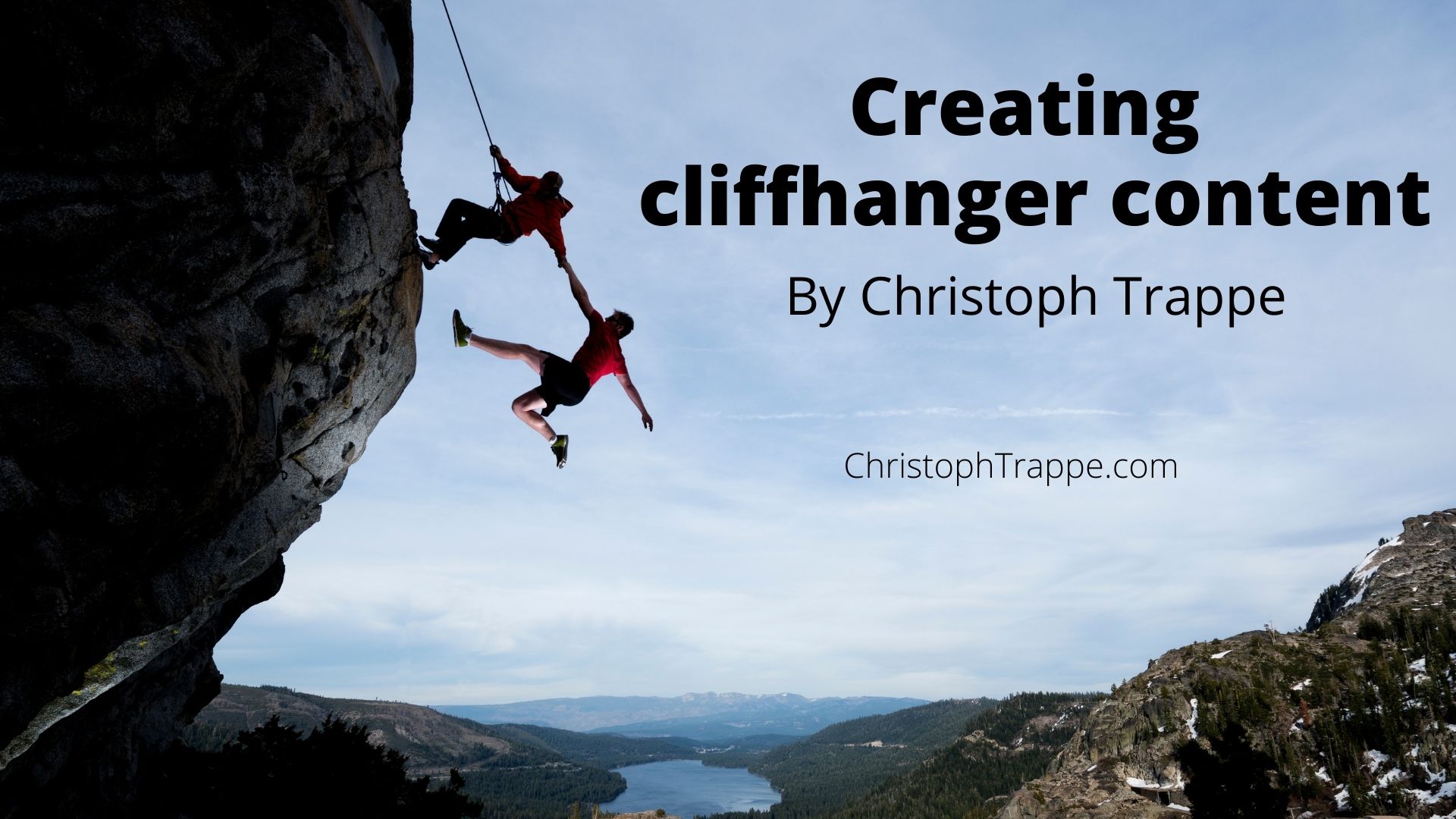Trappe Digital LLC may earn commissions from sponsored links and content. When you click and buy you also support us.
Getting people to come back to our business stories certainly can be a challenge. That doesn’t mean we can’t shouldn’t try. One way – at least in theory – is to create cliffhangers in our content. But ho how do we do that? Corporate storytelling is not like our favorite TV show’s main character hanging on to dear life or something like that on the last episode of the season.
But, why can’t corporate stories have better cliffhangers? Shane Salk – a narrative audio storyteller – joined me on the Business Storytelling Show and shared some ideas of how even businesses can add cliffhangers into their content.
What’s a cliffhanger anyway?
A cliffhanger is a method of storytelling where the audience is left wanting more. They don’t know what’s happening next and they really want to know. They can’t wait for the net episode or the next piece of content to drop on the topic. Here are some of the top TV cliffhangers.
As Shane said, a good cliffhanger will indeed make you feel somewhat frustrated. It leaves you hanging. The story isn’t complete. you want to know what’s next. That’s the point. When was the last time you read a blog, listened to a branded podcast, or watched a corporate video that left you with that feeling?
Cliffhangers in corporate storytelling
To an extent, when we say on podcasts: “Our next guest will be x and we’ll talk about y” that is a cliffhanger-type strategy. Depending on who the next guest is the cliffhanger might even work. If it’s a big name or the right topic, maybe people will come back because they heard the line.
In business storytelling, which is non-fiction, after all, the best way to achieve the “I want more of this content” is to share stories as they happen. I liken it to professional football. There’s always another chapter to the story.
- The next game
- Next season
- Off-season drama
- New stadiums
- Etc.
There’s always more that can and will happen.
Businesses can use that same concept, Shane explained. Just share stories as they happen and move forward from there. Stories can be told before they are complete so to speak and in that sense, many business stories are never really complete. There’s always another thing that can and will happen.
For example, a business could share the content around new product updates and even announce what’s next on the roadmap. I know I would love to know what the companies of the products that I use are up to next. Certainly, that can also tip competitors to what they might be copying next, so timing certainly matters.
Example: Joe Pulizzi announced on LinkedIn that he’s back in the event business and will share his new event tomorrow. That was certainly a post with a cliffhanger. And he was close to being ready to tell us about the event the next day.
Cliffhangers only work when you have an audience
The post from Joe seemed to work – in the sense of comments and likes – but see Joe has an audience. People follow him. They’ve learned from him over the years – myself included. People listen when he speaks.
Cliffhangers only work when people are consuming your content. When they are opening your emails, listening to your podcast, or seeing your social posts.
So you have to work on building your audience and keeping your audience before cliffhangers can be a winning piece of that strategy.
Once you have that dedicated audience, you can certainly give this strategy a try.
The danger of lame cliffhangers
There’s a real danger of adding cliffhangers because that’s now expected and we want to push for those results of repeat audiences.
But, don’t force it.
Sometimes I see this on TV. The television station runs a news story on its early-evening broadcast. And then they say “To hear more from the people involved in this join us again for our late-night show.” Now, if I already got the main headline and am not impacted by the story in any other way, that likely won’t get me to stay up late for the next news broadcast.
What’s the difference between a cliffhanger and a teaser?
A cliffhanger has a time element to it. A teaser wants you to do something now.
“You will regret it if you don’t click here now!” That’s a teaser.
“And Rachel just reached 1 million subscribers on YouTube, but as soon as she did, the number ticked up two more subscribers before decreasing by three and now showing 999,999….” That’s a cliffhanger. Will the subscriber count go back up? We won’t know until the next episode piece of content on the topic.
What content assets or types are best for cliffhangers?
I would think all of these could have cliffhangers:
- Blog posts
- Podcasts
- Short-form audio
- TikToks and other short-form videos – in fact, my cliffhanger example about YouTube subscribers above is an actual TikTok I saw from a creator.
Biggest takeaway
My biggest take-away perhaps from my chat with Shane was that business storytelling can make use of the cliffhanger if we continuously tell our story. There’s always another chapter – even if we don’t know what it will hold. That’s an automatically built-in cliffhanger right there. There likely will always be doubters or people who don’t like that strategy. They want to know all the answers now! They want that story to be complete. But it sharing our stories here and now, step by step, can help with:
- transparency
- brand recognition in the market
- authenticity
- and cliffhangers, which can keep audiences coming back.
Read next: Who is your audience? Is it internal or external?

